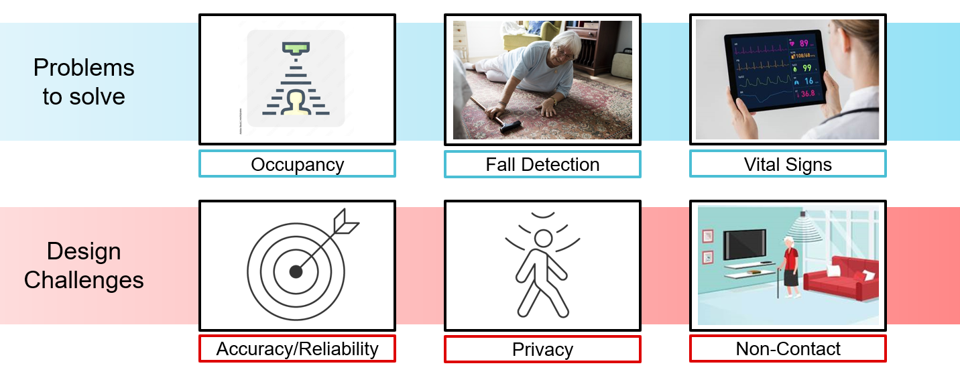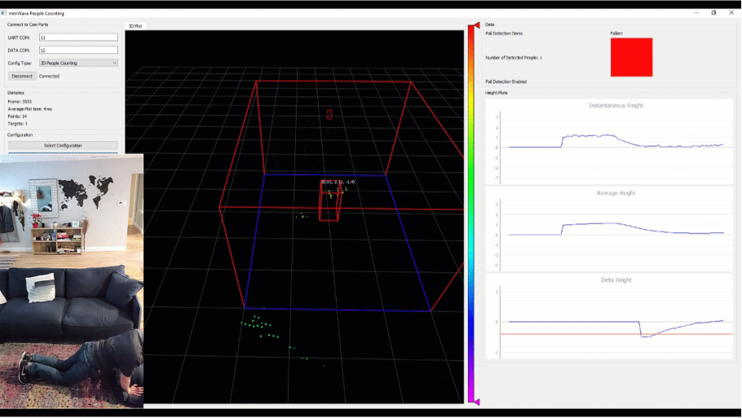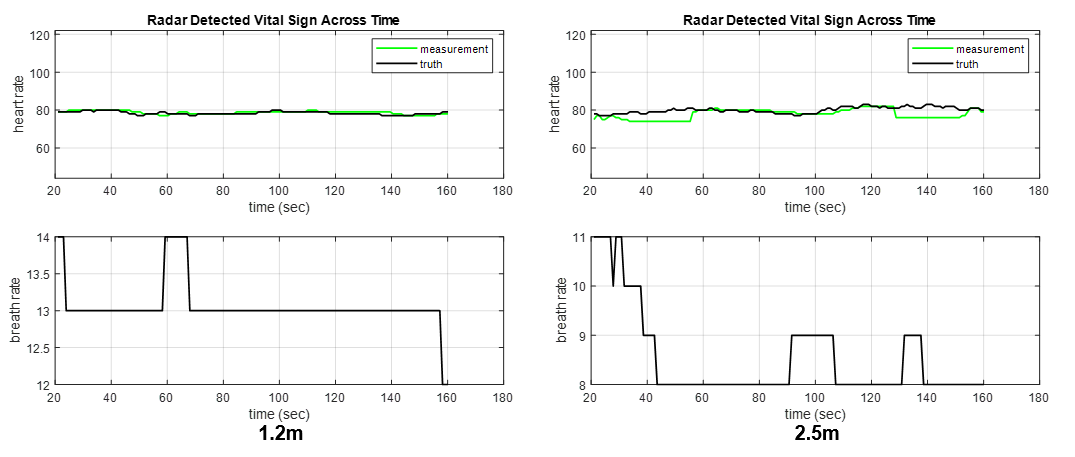SSZT103 january 2022 IWR6843AOP
With advances in medicine and health care, the average life expectancy of humans continues to increase. Virtually every country in the world is experiencing growth in the size and proportion of the elderly in their populations, with the total number of people aged 65 years or older projected to double to 1.5 billion in 2050. Concurrently, in-home care or nursing facilities must scale to support this increase.
According to the Centers for Disease Control and Prevention, nearly 25% of seniors fall every year, and falls are the leading cause of trauma-related hospital admissions in the U.S. among older adults. Learning when a fall or other health-related event occurs and being able to respond quickly can help make sure that the individual gets the care they need.
Today’s Technology – Wellness in the Home
Medical sensors, along with innovations in connectivity, are helping the elderly live normal lives in their homes with the assurance that help is close by if something happens. These medical sensors are typically accelerometer-based to detect movement signatures such as a fall, and can automatically call a family or caregiver for help.
The elderly must wear these battery-powered sensors around their neck or wrist; their location on the body helps the sensors identify macro movements such as a fall and uses a connection node to contact the family or caregiver. Additional sensors such as electrocardiograms or pulse oximeters may also provide a continuous view of health parameters such as vital signs or sleep quality.
These medical sensors have their own challenges, as shown in Figure 1. To be effective, the consumer must remember to wear and charge them, which may not always be comfortable or feasible. Some models require a button press in case of a health event, but this isn’t useful if the person is incapacitated. Finally, the sensors need to be very accurate in order to distinguish between fall events and daily activities. Today’s sensors can be prone to false detection when a person sits down quickly or claps their hands. Sensor types like those used in optical cameras also have privacy concerns when placed in a home.
 Figure 1 Technology Can Help Enable Wellness in the Home by Addressing Problems Such as Detection of Occupancy or Movement, Falls, and Vital Signs for Long-term Health Trends or Sleep Quality
Figure 1 Technology Can Help Enable Wellness in the Home by Addressing Problems Such as Detection of Occupancy or Movement, Falls, and Vital Signs for Long-term Health Trends or Sleep QualitymmWave Radar: Contactless, Privacy-conscious Sensing
60-GHz millimeter-wave (mmWave) radar is an alternative sensing technology for detecting and tracking wellness and behavior in the home. Radar helps solve multiple sensing challenges, including determining whether a room is occupied (and by how many people), identifying motion signatures to recognize a fall event, and measuring a person’s vital signs to assess things like sleep quality. By its very nature as a radio-frequency-based sensor, mmWave radar senses without contacting the body, and since the sensor does not provide any visually identifiable information, it can be mounted in sensitive areas such as a bedroom or bathroom. Combining these functions together at the application level can help an in-home monitoring system give loved ones and caregivers reassurance that a person is safe and healthy.
The IWR6843AOP uses on-chip antennas and onboard processing with a microcontroller and digital signal processor to process range, velocity and angle of targets. The range and angle information can be used to generate a "point cloud," which when fed into a historical tracker can determine not only if a room is occupied, but where someone is located in that room. This point cloud and tracker information can be used to determine whether a person is moving or sedentary, or if they are exhibiting normal behavior such as walking to the kitchen in the morning.
Using the example of a radar point cloud indicating a fall, Figure 2 illustrates the point cloud in green dots, with a red track assigned to the cluster. The graphs on the right show the measure of the person’s instantaneous and average height, which an algorithm could use to detect whether a person has fallen.
 Figure 2 Example of a Radar Point Cloud from a Person Who Has Fallen
Figure 2 Example of a Radar Point Cloud from a Person Who Has FallenVelocity information can measure the motion signatures of targets in the room. With tailored algorithms or artificial intelligence, these motion signatures can identify behaviors such as an unsteady gait, a fall or a near-fall. Another use is by a bedside to measure movement during sleep and determine whether sleep patterns are changing. As shown in Figure 3, motion signatures can even measure heart and breathing rates when a person is sitting or lying down.
 Figure 3 Heart and Breathing Rates Measured Using the IWR6843AOP Sensor Mounted at Chest Height from a Sitting Person 1.2 M and 2.5 M Away.
Figure 3 Heart and Breathing Rates Measured Using the IWR6843AOP Sensor Mounted at Chest Height from a Sitting Person 1.2 M and 2.5 M Away.In Figure 3, the top graphs use a chest-mounted commercial heart-rate monitor (black line) for comparison with the IWR6843AOP’s processed output (green line). The heart-rate error was <5 bpm vs. ground truth from a chest-mounted sensor, demonstrating good measurement accuracy without the need for the sensor to contact the body.
Conclusion
mmWave radar is a growing technology that is a good fit for new and innovative capabilities in the home-monitoring and medical space. Check out some of the resources linked in this article and listed below to learn more about mmWave radar sensors, including evaluation modules, demonstration software or a solution from one of our third-party partners.
Additional Resources
- Order the IWR6843AOP evaluation module or IWR6843ISK intelligent mmWave sensor standard antenna plug-in module.
- Learn more about other applications for mmWave in the industrial toolbox for mmWave sensors.
- Download the mmWave radar sensors third-party search tool.
- Watch the mmWave Vital Signs Lab